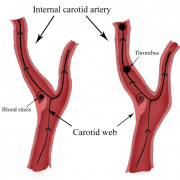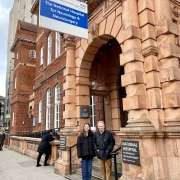Stroke Associated Pneumonia: better safe than sorry
Giuseppe Reale, MD, Catholic University of the Sacred Heart – A. Gemelli University Hospital, Rome
The recent amazing advancements in the field of stroke reperfusion therapy make us hope for a considerable increase of treated patients with subsequent favorable outcomes in terms of disability. However, medical complications occurring during the hospital stay can easily spoil the aforementioned achievements.
Infections are a frequent medical complication of acute stroke and influence clinical outcomes1,2. Pneumonia occurs in about 10% of acute ischemic stroke patients, especially in the first week after admission, with a three-fold increase in mortality and poor outcome in survivors3,4.
According to the Pneumonia in Stroke Consensus (PISCES) Group, stroke associated pneumonia (SAP) defines the spectrum of low respiratory tract infections complicating stroke in the first week; after this period, the term hospital acquired pneumonia (HAP) is preferable5.
Because of the high mortality and disability rate associated to SAP, many aimed to find a strategy to prevent post-stroke pneumonia and its complications. Patients at particular risk of SAP are those with severe stroke symptoms and high disability, patients with dysphagia, severe dysarthria or aphasia, impaired consciousness, pharmacological gastric acid suppression, older age, atrial fibrillation, diabetes mellitus6-8.
Aspiration is thought to be the key causative mechanism of SAP8,9, probably together with other triggering features, such as stroke related immunodepression10. Stroke-related dysphagia and/or decreased level of consciousness with subsequent impairment of the cough reflex and glottic closure are the principle cause of aspiration11.
Because of the bacterial aspiration theory, several studies investigated the efficacy of preventive antibiotic therapy, but a 2012 metanalysis showed that antibacterial prophylactic treatment leads to a reduction of SAP rate but does not improve the three months clinical outcomes12. These results were confirmed by a recent, large multi-center randomized trial that showed no difference between prophylaxis ceftriaxone-treated patients and the standard care group13.
Given this, it seems that initial fasting and dysphagia screening on admission still are the most important measure to prevent pneumonia in patients with acute stroke, being the use of a formal protocol (sheet check and water swallow test) associated to a three-fold reduced incidence of SAP14. Thus, it is reasonable to assess all patients for their swallowing function prior to administering oral medications or food, regardless the clinical severity15.
Better safe than sorry.
References
- Katzan IL, Dawson NV, Thomas CL, Votruba ME, Cebul RD. The cost of pneumonia after acute stroke. Neurology. 2007;68:1938–1
- Koennecke HC, Belz W, Berfelde D, et al; Berlin Stroke Register Investigators. Factors influencing in-hospital mortality and morbidity in patients treated on a stroke unit. 2011;77:965–972.
- Finlayson O, Kapral M, Hall R, Asllani E, Selchen D, Saposnik G, Canadian Stroke Network, Stroke Outcome Research Canada (SORCan) Working Group. Risk factors, inpatient care, and outcomes of pneumonia after ischemic stroke. Neurology. 2011;77:1338-1345.
- Westendorp WF, Nederkoorn PJ, Vermeij JD, Dijkgraaf MG, van de Beek D. Post-stroke infection: a systematic review and meta-analysis. BMC Neurol. 2011;11:110.
- Smith CJ, Kishore AK, Vail A, Chamorro A, Garau J, Hopkins SJ, Di Napoli M. Diagnosis of Stroke-Associated Pneumonia: Recommendations From the Pneumonia in Stroke Consensus Group. Stroke. 2015;46:2335-2340
- Sellars C, Bowie L, Bagg J, et al. Risk factors for chest infection in acute stroke: a prospective cohort study. Stroke. 2007;38:2284-2291
- Hilker R, Poetter C, Findeisen N, et al. Nosocomial pneumonia after acute stroke: implications for neurological intensive care medicine. Stroke. 2003;34:975-981.
- Johnston KC, Li JY, Lyden PD, et al. Medical and neurological complications of ischemic stroke: experience from the RANTTAS trial. Stroke. 1998;29:447-453
- Hannawi Y, Hannawi B, Rao CP, Suarez JI, Bershad EM. Stroke-associated pneumonia: major advances and obstacles. Cerebrovasc Dis. 2013;35:430-443.
- Dirnagl U, Klehmet J, Braun JS, et al: Stroke induced immunodepression: experimental evidence and clinical relevance. Stroke. 2007;38:770–773.
- Dysphagia after stroke: incidence, diagnosis, and pulmonary complications. Martino R, Foley N, Bhogal S, Diamant N, Speechley M, Teasell R. Stroke. 2005;36:2756-2763
- Westendorp WF, Vermeij JD, Vermeij F, et al: Antibiotic therapy for preventing infections in patients with acute stroke. Cochrane Database Syst Rev 2012;1:CD008530
- Westendorp WF, Vermeij JD, Zock E, et al; PASS investigators. The Preventive Antibiotics in Stroke Study (PASS): a pragmatic randomised open-label masked endpoint clinical trial. Lancet. 2015;385:1519-1526.
- Hinchey JA, Shephard T, Furie K, Smith D, Wang D, Tonn S, Stroke Practice Improvement Network Investigators. Formal dysphagia screening protocols prevent pneumonia. Stroke. 2005;36(9):1972-1976
- Powers WJ, Rabinstein AA, Ackerson T, et al. 2018 Guidelines for the Early Management of Patients With Acute Ischemic Stroke: A Guideline for Healthcare Professionals From the American Heart Association/American Stroke Association. Stroke. Jan 24




